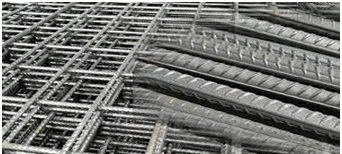Build our houses strong. No one can find a fault in this motto. Everyone needs their buildings to last the tests that time has in store for them. So it is quite natural that we tend to opt for the latest steel grades when they arrive on the scene. Today BIS, through its latest amendment of IS 1786:2008 (Amendment no.3, March 2017) has specified different grades of TMT Steel bars such as Fe 415, Fe 500, Fe 550, Fe 600,Fe 650 & Fe 700. Also BIS specified Ductile (D) & Seismic (S) versions for different applications. The latest entrant to the grades is the seismic variant (S) i.e., like Fe 500S. As customers, it’s our responsibility to make sure that the products we buy are appropriate for our needs.
Do we need to evaluate the seismic performance of the buildings?
The grades with Seismic (S) extension are introduced due to the increasing demand for high ductile TMT steel bars, on the basis of the probability of severe earthquakes in India. Geographical statistics of India show that 54% of the lands in India are vulnerable to earthquakes. It is estimated that around 200 million people in India will be exposed to heavy storms and earthquakes by 2050.This is based on the study reports of World Bank and United Nations on natural calamities.
The seismic Zoning map of India divides the country into four seismic zones. The earlier version had six zones for India. But the present four seismic zones are zone 2, zone 3, zone 4 & zone 5. As per the current zoning map, zone 2 is having lowest level of seismic proneness while zone 5 expects the highest level of seismic activity. North East, Kutch, Andaman Nicobar, Goa, Himachal, West UP & Gujarat are identified as high risk seismic prone areas in India. The Himalayan belt is considered to be prone to great earthquakes of magnitude exceeding 8. We should understand that India is the first country to develop codes on low strength non-engineered masonry constructions. Tremendous energy is dissipated when Indian plates drift each other, which causes tremors. We had around four severe earthquakes within the last 50 years, all resulting in either moderate or severe casualties.
It’s a fact that the construction sector in India is growing tremendously. As most of the new buildings in our country are reinforced concrete buildings, we must analyse and evaluate the seismic resistance performance of these buildings.
Points to remember while doing seismic resistant design for buildings
Analysing the proven experience from earth quake prone countries regarding the seismic resistance design and the standards for concrete structures will help to improve the seismic performance of concrete building, thus minimizing the losses caused by earthquakes.
While doing Seismic resistant design for buildings, we must keep the following three points in our mind. The first basic principle of seismic resistant design & detailing is that minor and frequent earthquakes should not cause any damage to the structures. The second point is that moderate earthquakes should not cause any significant structural damage eventhough it may result in some nonconstructional damages. The third and the most important point to be followed in seismic resistant design & detailing is that the major and infrequent earth quakes should not cause collapse of buildings.
In short, eventhough a building is meant to have a design life for 100 years, one must design it to remain unchanged for a large earthquake that takes place, say once in 500 years.
Role of reinforcement steel bars in making buildings seismic resistant
One must understand that the reinforced concrete members will undergo large inelastic deformation for adequate energy dissipation. Quality of TMT Steel reinforcing bars determines the flexural capacity & post yield behavior of a reinforced member. Thus the mechanical properties of TMT Steel Bars like yield strength, ultimate tensile strength to yield strength ratio, elongation percentage are very important. The method of TMT Steel bars manufacturing determines these parameters.
Over the years TMT Steel Bars became the gold standard when it comes to concrete reinforcement. The combination of tensile strength and ductility that it provides has made it the choice of the builders. These properties are no accident. They are result of a carefully planned process, executed using state of the art technology. At the first look, the technology looks quite simple. The TMT Steel Bars are manufactured by rapid quenching of the hot bars for small amount of time. The rapid cooling causes the outer layer of the TMT to settle in to a hard martensite structure that is high in tensile strength. The water jet is stopped even as the inner core of the rebar remains hot. The inner core then cools down at room temperature forming a soft ferrite pearlite that gives the rebar its ductility. The thickness of the inner core and outer layer determines the grade of the TMT steel rebars.

BIS has specified different grades for different applications. Each of these grades has their own strengths and limitations. If tensile strength is the only consideration, Fe 700 would be the most suitable.Fe-415 grade would be the ideal choice for buildings in seismically active zones that require both tensile strength and ductility. Some engineers advise customers that using high strength would help to decrease quantity of steel and would also reduce column sizes. But they fail to mention that the increased strength comes at the expense of other important characteristics of steel such as ductility and workability that too play a significant role in providing strength to buildings.
Which TMT grade gives real earthquake resistance?
Different grades of TMT steel can be produced by tweaking the TMT process. If the steel is quenched more, the outer martensite layer will become thicker at the expense of soft inner core. Such TMT bars have more strength but less ductility. The Bureau of Indian Standards has set the minimum ductility in grades like Fe 415, Fe 500 & Fe 550 as 14.5%, 12%, 8% elongation respectively. Thus reductions in ductility have grave consequences for the safety the buildings, especially during earthquakes.

Studies have brought out the difficulties associated with the use of higher strength grades like Fe 500, Fe 550 etc under cyclic loading, particularity seismic zone 3 & 4. So while considering seismic performance of TMT Steel bar grades, all the higher strength grades are not suitable for using in seismic prone zones. Only options left are Fe 415 and higher strength grades with ‘S’ (seismic) extension like Fe 500S. Now let’s look in to the best option for earthquake resistance among Fe 415 and higher strength grades like Fe 500S. Theoretically both are suitable for use in seismic zones. But practically it is proved that Fe 415 TMT bars have the right mix of tensile strength and ductility that is appropriate for buildings in regions under seismic zones. Building might have to face dynamic and seismic loads, during their life time. The ductility of Fe 415 steel bars enables them to beat such loads. But in the case of TMT grades like Fe 500S, it is difficult to achieve and maintain the yield strength and ductility through TMT process alone. Besides we need to have certain micro alloying precipitation hardening elements. The balance of both QST and micro alloying process is extremely important. Any severe imbalance in both can lead to sacrifices on the essential properties –yield strength and ductility trade off.
Micro Alloying of precipitation hardening elements
Steel manufacturers are using microalloying principles developed earlier for flat-rolled plates and sheet products in TMT steel bar manufacturing also. They tried to use conventional microalloying processes that employ precipitation or austenite conditioning using certain elements like Niobium(Nb),vanadium(V),Titanium(Ti)etc.
Certain experimental results on effects of micro alloying on TMT steel bars shows that an addition of certain percentage of elements lead to an effective increase in strength. This strengthening is caused by precipitation hardening and grain refinement hardening.But in the case of TMT steel bars that require higher strength, the level of the controlling mechanisms of micro alloying are less developed. Currently these process developments are very empirical in nature. But there is an opportunity to advance the fundamental metallurgical microalloying processes in TMT steel bars for product improvement.
The most important outcome that needs attention in Fe 500S, manufactured using micro alloying, is the development of percentage of tempered martensite formed in the TMT bar. Care must be taken so that this value should not exceed 5-9%, otherwise the yield strength would increase uncontrollably. Thus minimum required high UTS to YS ratio would be compromised due to reduction in gap between YS and UTS. Also percentage elongation required for seismic resistance properties would reduce. This is due to the presence of relatively hard phase that is tempered martensite. In short TMT grade variants like Fe-500S should contain such elements which help to increase UTS to YS ratio.
So between two options, TMT grade variants like Fe 500S have more chance for sudden failure or collapse due to more toughness, if micro alloying precipitation hardening elements are not properly formed. In fact, IS 13920 the code of practice for ductile detailing for structures of seismic forces, recommend steel reinforcements with Fe 415. Requirements specified in IS 1786:2008 for Fe 415 grade TMT bars are also in line with those of other seismic prone countries, for ductile design. So Fe 415 is the only and best option available while considering seismic resistance performance of RCC buildings, atleast as of now.
REFERENCES:
1)“A clear and present danger in use of High Grade TMT in Seismic Zones”-Emilio M.Morales(Fellow in Civil Engineering, Carnegie Mellon University).
2) “New Zealand Standard 3101:2006”: Concrete Structures
3) “Critical Properties of Seismic Resistant Rebars” – Dr.A.M.Elmaghrabi P.hD (Inorganic and analytical Chemistry).
4) “Indian Standard Specification for High Strength deformed bars and wires for concrete reinforcement (third revision),IS 1786:2008”; Bureau of Indian Standards,New Delhi
5) “Effects of Microalloying Elements on Mechanical Properties of Reinforcing Bars” by Shunichi Hashimoto, Morifumi Nakamura
Authored By;


